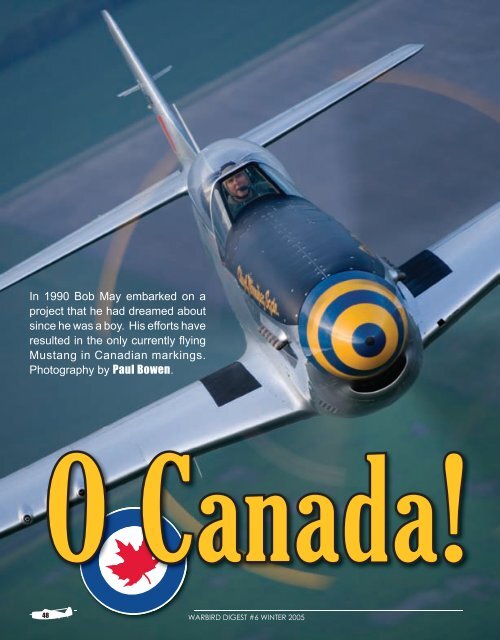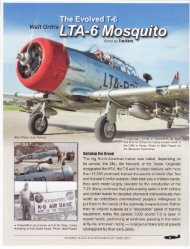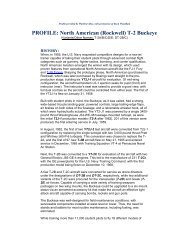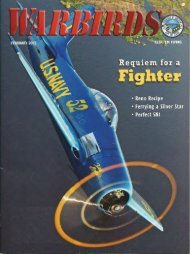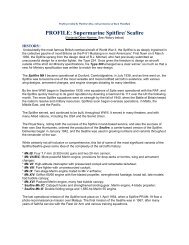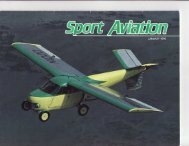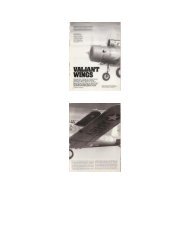to view Warbird Digest's Article on this ... - Courtesy Aircraft
to view Warbird Digest's Article on this ... - Courtesy Aircraft
to view Warbird Digest's Article on this ... - Courtesy Aircraft
You also want an ePaper? Increase the reach of your titles
YUMPU automatically turns print PDFs into web optimized ePapers that Google loves.
In 1990 Bob May embarked <strong>on</strong> a<br />
project that he had dreamed about<br />
since he was a boy. His efforts have<br />
resulted in the <strong>on</strong>ly currently fl ying<br />
Mustang in Canadian markings.<br />
Pho<str<strong>on</strong>g>to</str<strong>on</strong>g>graphy by Paul Bowen.<br />
O Canada!<br />
48 WARBIRD DIGEST #6 WINTER 2005
In late 1950, twenty-five P-51 Mustangs were delivered<br />
<str<strong>on</strong>g>to</str<strong>on</strong>g> Uruguay. This delivery was the result of very thorough<br />
planning <strong>on</strong> the part of the leaders of the Fuerza Aérea<br />
Uruguaya (FAU). The FAU was originally slated <str<strong>on</strong>g>to</str<strong>on</strong>g> receive P-<br />
47D Thunderbolts as early as 1946. These were <str<strong>on</strong>g>to</str<strong>on</strong>g> be supplied<br />
under the American Republic Project, the predecessor of<br />
the Military Assistance Program. They turned down these<br />
essentially free fighters in favor of a future purchase of<br />
Mustangs they would have <str<strong>on</strong>g>to</str<strong>on</strong>g> pay for. In 1948 the leaders<br />
of the FAU with the assistance of U.S. military advisors<br />
developed a plan <str<strong>on</strong>g>to</str<strong>on</strong>g> obtain Mustangs and B-25 Mitchells <str<strong>on</strong>g>to</str<strong>on</strong>g><br />
equip a fighter group and bomber group respectively.<br />
In 1949 thirty-five pilots and technicians were sent <str<strong>on</strong>g>to</str<strong>on</strong>g> the United<br />
States <str<strong>on</strong>g>to</str<strong>on</strong>g> form the core of the fighter group. When the deliveries<br />
began in November 1950, the twenty-five aircraft were serialed<br />
FAU 252 <str<strong>on</strong>g>to</str<strong>on</strong>g> FAU 274. Although Uruguay would operate the P-<br />
51 until 1960, it would not be an al<str<strong>on</strong>g>to</str<strong>on</strong>g>gether pleasant experience.<br />
There was a reas<strong>on</strong> why the U.S. had offered P-47s <str<strong>on</strong>g>to</str<strong>on</strong>g> the vast<br />
majority of Latin American countries. Most of those air arms<br />
had previous experience maintaining aircraft with radial engines<br />
and there was c<strong>on</strong>cern that the liquid systems in the Mustang<br />
would cause serviceability issues. This, combined with the lack<br />
of spare parts as the result of the Korean War, would at times<br />
reduce the number of combat ready aircraft <str<strong>on</strong>g>to</str<strong>on</strong>g> as low as six. By<br />
1960, the Mustangs were struck off charge by the FAU. Eight<br />
of the best airframes were sold <str<strong>on</strong>g>to</str<strong>on</strong>g> Bolivia and the remaining<br />
were scrapped, save two, FAU 265 and FAU 274 which were<br />
saved for display. Both of those aircraft were returned <str<strong>on</strong>g>to</str<strong>on</strong>g> the<br />
United States in 1984. That would have been the end of the<br />
Uruguayan Mustang s<str<strong>on</strong>g>to</str<strong>on</strong>g>ry if not for Canadian Bob May.<br />
Bob and Judy May with Bob Odegaard relax<br />
after the <str<strong>on</strong>g>Warbird</str<strong>on</strong>g> Digest pho<str<strong>on</strong>g>to</str<strong>on</strong>g> missi<strong>on</strong>.<br />
May grew up <strong>on</strong> a farm in Mani<str<strong>on</strong>g>to</str<strong>on</strong>g>ba not far from Carberry,<br />
where the Royal Canadian Air Force was s<str<strong>on</strong>g>to</str<strong>on</strong>g>ring their remaining<br />
Mustang inven<str<strong>on</strong>g>to</str<strong>on</strong>g>ry. He stumbled across the airplanes while<br />
WARBIRD DIGEST #6 WINTER 2005<br />
49
helping his father run the family farm. May picks up the<br />
s<str<strong>on</strong>g>to</str<strong>on</strong>g>ry. “Back in the mid-sixties when I was a teenager,<br />
probably 14 or 15 years old, the government had s<str<strong>on</strong>g>to</str<strong>on</strong>g>red the<br />
surplus Mustangs of the RCAF Winnipeg Reserve Squadr<strong>on</strong><br />
out at Carberry, which was about 20 miles from where I<br />
lived. They were going <str<strong>on</strong>g>to</str<strong>on</strong>g> close the airport and make it in<str<strong>on</strong>g>to</str<strong>on</strong>g><br />
a pota<str<strong>on</strong>g>to</str<strong>on</strong>g> processing plant. My Dad sent my brothers and me<br />
down <str<strong>on</strong>g>to</str<strong>on</strong>g> pick up some bricks and shingles that they were<br />
selling surplus. Every time my Dad turned his back I was off<br />
down the hangar line looking at the Mustangs that they had<br />
dragged out. There were about fifteen of them, if I recall.<br />
They were lined up there and they were so worthless at the<br />
time that Simplot, out of Idaho, who were trying <str<strong>on</strong>g>to</str<strong>on</strong>g> turn<br />
the whole airport in<str<strong>on</strong>g>to</str<strong>on</strong>g> the processing plant, threatened <str<strong>on</strong>g>to</str<strong>on</strong>g><br />
bulldoze them out of the way if the people that bought them<br />
didn’t get them out of there. These were parts airplanes, and<br />
they had magne<str<strong>on</strong>g>to</str<strong>on</strong>g>s, switches, and <strong>this</strong> and that missing. The<br />
guys that had bought them were busy trying <str<strong>on</strong>g>to</str<strong>on</strong>g> get them<br />
flying so they could move them. As the years went by, I<br />
learned that a lot of those airplanes were the survivors that<br />
went <str<strong>on</strong>g>to</str<strong>on</strong>g> the States and are still flying <str<strong>on</strong>g>to</str<strong>on</strong>g>day.”<br />
“Anyway, that was <strong>this</strong> farm kids first chance <str<strong>on</strong>g>to</str<strong>on</strong>g> get up<br />
close <str<strong>on</strong>g>to</str<strong>on</strong>g> an airplane. Since <strong>this</strong> was my first real aviati<strong>on</strong><br />
experience, I think I just thought that all airplanes were<br />
supposed <str<strong>on</strong>g>to</str<strong>on</strong>g> look like P-51s. From that point <strong>on</strong> I had kind of<br />
thing for Mustangs and aviati<strong>on</strong> in general.” May even tried<br />
<str<strong>on</strong>g>to</str<strong>on</strong>g> c<strong>on</strong>vince his Dad <str<strong>on</strong>g>to</str<strong>on</strong>g> buy <strong>on</strong>e of the Carberry Mustangs.<br />
“I remember saying at the time, ‘Geez Dad, we should buy<br />
<strong>on</strong>e of these. He said, ‘nah those old warplanes aren’t worth<br />
anything.’ He is l<strong>on</strong>g g<strong>on</strong>e, now, but I was back <strong>on</strong> the farm<br />
<strong>on</strong>e day and as I was walking I stumbled over <strong>this</strong> bump.<br />
I kicked grass and there was the pile of bricks he had us<br />
bring home from Carberry. He had never used them and<br />
they were still laying there!”<br />
5(<str<strong>on</strong>g>to</str<strong>on</strong>g>p) The line-up of ex-RCAF Mustangs at Carberry.<br />
Pho<str<strong>on</strong>g>to</str<strong>on</strong>g>: Dick Philips Collecti<strong>on</strong>.<br />
5(middle) FAU 252 in s<str<strong>on</strong>g>to</str<strong>on</strong>g>rage in Uruguay while May went through the<br />
legal process <str<strong>on</strong>g>to</str<strong>on</strong>g> obtain the right <str<strong>on</strong>g>to</str<strong>on</strong>g> ship the airplane.<br />
Shortly after being recovered FAU 252 basks in the sun <strong>on</strong> the shore<br />
of the Rio Negro.<br />
50 WARBIRD DIGEST #6 WINTER 2005
May decided <str<strong>on</strong>g>to</str<strong>on</strong>g> pursue an aviati<strong>on</strong> career, starting out by flying<br />
in the bush planes in the northern terri<str<strong>on</strong>g>to</str<strong>on</strong>g>ries of Canada. He<br />
then tried the airline business, but didn’t find that he enjoyed<br />
it. Eventually he would obtain a license <str<strong>on</strong>g>to</str<strong>on</strong>g> operate a business<br />
in the arctic and formed Keewatin Air. Early <strong>on</strong> they operated<br />
aircraft such as deHavilland Beavers and Cessna 185s in<str<strong>on</strong>g>to</str<strong>on</strong>g><br />
back country airstrips. In recent years Keewatin has operated<br />
turbo props such as the Pilatus PC-12 and King Air 200. May<br />
was never able <str<strong>on</strong>g>to</str<strong>on</strong>g> get the Mustang out of his blood. “Every<br />
few years I would check and find out that they weren’t 500<br />
dollars anymore they were $25,000 then $125,000 and so <strong>on</strong>.<br />
It was always just out of reach. Five hundred dollars was just<br />
as much out of the questi<strong>on</strong> when I was fifteen than $25,000<br />
when I was twenty-five. I decided, ‘Well if I am going <str<strong>on</strong>g>to</str<strong>on</strong>g><br />
have a Mustang I guess I better start putting <strong>on</strong>e <str<strong>on</strong>g>to</str<strong>on</strong>g>gether.’<br />
I started back in about 1990 buying parts, going through<br />
Trade-A-Plane and getting <strong>on</strong> the ph<strong>on</strong>e and calling people<br />
and looking for pieces. Eventually I heard about a guy in the<br />
States who had a Mustang project for sale.”<br />
5(<str<strong>on</strong>g>to</str<strong>on</strong>g>p) The beginning of the wing in Odegaard Aviati<strong>on</strong>’s jig.<br />
5(middle) The two wings are mated and prepared for the installati<strong>on</strong><br />
of the fuel tanks.<br />
May made c<strong>on</strong>tact with Californian Rocky Medina who<br />
had located a Mustang that might be possible <str<strong>on</strong>g>to</str<strong>on</strong>g> recover<br />
in Uruguay. On August 8, 1956 FAU 252 USAAF Serial<br />
No. 44-63476 was lost in the Rio Negro River while <strong>on</strong><br />
a training missi<strong>on</strong>. The young pilot, Jorge E. Thomasset<br />
was killed. “I called Rocky Medina and for the next four<br />
years we were pretty much joined at hip. He had actually<br />
learned about the airplane in a book about Latin American<br />
Mustangs. The book had the identities a bit off, but Rocky<br />
had g<strong>on</strong>e down there and gotten salvage rights, but hadn’t<br />
found anything yet. I went down <str<strong>on</strong>g>to</str<strong>on</strong>g> Los Angeles and we<br />
struck a deal. As Rocky explained it, getting the rights <str<strong>on</strong>g>to</str<strong>on</strong>g><br />
perform the recover <str<strong>on</strong>g>to</str<strong>on</strong>g>ok quite a while. I would later learn<br />
first hand that when you are dealing with the Uruguayans<br />
you had <str<strong>on</strong>g>to</str<strong>on</strong>g> have a lot of time.”<br />
The big day. The wing and the fuselage are mated <str<strong>on</strong>g>to</str<strong>on</strong>g>gether.<br />
WARBIRD DIGEST #6 WINTER 2005<br />
51
Medina had <str<strong>on</strong>g>to</str<strong>on</strong>g> obtain the permissi<strong>on</strong> of Thomasset’s widow<br />
and a number of junior FAU commanders for the recovery.<br />
As May unders<str<strong>on</strong>g>to</str<strong>on</strong>g>od it, “The widow of the young pilot had<br />
never remarried. It was sort of <strong>on</strong>e of those Latin tragedies,<br />
she had just gotten married when he was killed. She was<br />
around 80 I think, when Rocky spoke <str<strong>on</strong>g>to</str<strong>on</strong>g> her , and she was<br />
still in love with a young Lieutenant., but she decided that it<br />
would be okay <str<strong>on</strong>g>to</str<strong>on</strong>g> salvage <strong>this</strong> thing.”<br />
The area where the crash <str<strong>on</strong>g>to</str<strong>on</strong>g>ok place was range land, with a large<br />
man made lake created by a hydro-electric dam in the Rio Negro.<br />
In the middle of the lake, about ¾ mile from shore was an island.<br />
The FAU had placed targets <strong>on</strong> the island and it was used for<br />
bombing and gunnery range. Thomasset crashed in<str<strong>on</strong>g>to</str<strong>on</strong>g> the lake<br />
while <strong>on</strong> a practice bombing missi<strong>on</strong>. According <str<strong>on</strong>g>to</str<strong>on</strong>g> May, “I<br />
guess the accident occurred because the guy had like 40 hours<br />
<str<strong>on</strong>g>to</str<strong>on</strong>g>tal time. It was his first day out practicing dropping bombs.<br />
They had little practice bombs <strong>on</strong> the airplane. It was a gray day<br />
and the water was flat and glassy. He didn’t recognize the danger<br />
and flew it in<str<strong>on</strong>g>to</str<strong>on</strong>g> the surface of the water.”<br />
On his trips <str<strong>on</strong>g>to</str<strong>on</strong>g> Uruguay, Medina located a woman who had<br />
been a young girl when FAU 252 crashed. She was c<strong>on</strong>vinced<br />
she knew the exact locati<strong>on</strong> of the crash-site. May and Medina<br />
started their search there. May was c<strong>on</strong>fident it would be a<br />
quick recovery so he went <str<strong>on</strong>g>to</str<strong>on</strong>g> Uruguay in 1991, “We were so<br />
sure that it was <strong>on</strong>ly going <str<strong>on</strong>g>to</str<strong>on</strong>g> be a matter of a few days of<br />
looking around out there, that my wife and family went down<br />
<str<strong>on</strong>g>to</str<strong>on</strong>g> witness all the events. Well, it didn’t quite turn out that way.<br />
It would take additi<strong>on</strong>al trips and another year before we found<br />
the airplane about three miles from where the eyewitness said it<br />
had crashed. The young girl’s account could have been right, it<br />
may have floated away It was in about sixty feet of water.”<br />
During their 1992 expediti<strong>on</strong>, Medina and May began <str<strong>on</strong>g>to</str<strong>on</strong>g><br />
understand why so many airplane hunters have g<strong>on</strong>e <str<strong>on</strong>g>to</str<strong>on</strong>g> Latin<br />
America and returned empty handed, and a lot poorer. “We were<br />
staying in a little place called Placa del la Toros, a little cow<br />
<str<strong>on</strong>g>to</str<strong>on</strong>g>wn community. That meant place of the bulls or something<br />
al<strong>on</strong>g those lines, but my kids called it the place of lost <str<strong>on</strong>g>to</str<strong>on</strong>g>urists<br />
because we were the <strong>on</strong>ly <strong>on</strong>es there. Of course being a couple<br />
of Canadians, staying in the best hotel in <str<strong>on</strong>g>to</str<strong>on</strong>g>wn, which my<br />
recollecti<strong>on</strong> was three dollars a night, with a screen door <strong>on</strong> it,<br />
the people, who were very gracious became very curious about<br />
what was going <strong>on</strong>. The local equivalent of the Communist party,<br />
which was like Greenpeace and everything else all rolled in<str<strong>on</strong>g>to</str<strong>on</strong>g> <strong>on</strong>e,<br />
decided that what must be going <strong>on</strong> was that the government must<br />
be c<strong>on</strong>sidering placing a nuclear power plant in the area around<br />
the lake. Somebody snuck in<str<strong>on</strong>g>to</str<strong>on</strong>g> the area and peeked in<str<strong>on</strong>g>to</str<strong>on</strong>g> our tents<br />
and saw our side scan s<strong>on</strong>ar and magne<str<strong>on</strong>g>to</str<strong>on</strong>g>meter equipment. They<br />
didn’t know what it was, but it was hi-tech equipment, so they<br />
thought it verified their s<str<strong>on</strong>g>to</str<strong>on</strong>g>ry of what was going <strong>on</strong>. The next<br />
thing we know we have dem<strong>on</strong>strati<strong>on</strong>s going <strong>on</strong> out there and<br />
the press came <str<strong>on</strong>g>to</str<strong>on</strong>g> find out what was going <strong>on</strong>. We kept telling<br />
them we were just looking for an old airplane in a lake. They<br />
were quite sure that we were out there checking the depth of the<br />
lake <str<strong>on</strong>g>to</str<strong>on</strong>g> see if they could meet the proper cooling requirements<br />
for a nuclear plant.”<br />
Suddenly, senior members of the FAU and the nati<strong>on</strong>al<br />
museum were being questi<strong>on</strong>ed by the press. The embarrassed<br />
officers were forced <str<strong>on</strong>g>to</str<strong>on</strong>g> take acti<strong>on</strong> <str<strong>on</strong>g>to</str<strong>on</strong>g> save face according <str<strong>on</strong>g>to</str<strong>on</strong>g><br />
May. “The FAU really didn’t want the airplane. They weren’t<br />
proud of the fact that it had crashed and they hadn’t had a<br />
whole lot of luck with the Mustang. However, since the issue<br />
had been raised that some<strong>on</strong>e was stealing a nati<strong>on</strong>al treasure,<br />
they had <str<strong>on</strong>g>to</str<strong>on</strong>g> do something. They didn’t seize the airplane, but<br />
52 WARBIRD DIGEST #6 WINTER 2005
6(middle) Bob May bound <strong>this</strong> Merlin engine in s<str<strong>on</strong>g>to</str<strong>on</strong>g>rage in Quebec.<br />
It was pho<str<strong>on</strong>g>to</str<strong>on</strong>g>graphed shortly after he obtained it and before it was<br />
overhauled by Dwight Thorne’s Mystery Aire. This is proof positive<br />
that parts of World War Two airplanes are still squirreled away<br />
around the world.<br />
we were forced <str<strong>on</strong>g>to</str<strong>on</strong>g> go through their process, which involved<br />
suing the FAU and the government. Instead of putting the thing<br />
in a c<strong>on</strong>tainer and taking it home, we spent another two years<br />
suing the air force. It wasn’t expensive or c<strong>on</strong>fr<strong>on</strong>tati<strong>on</strong>al, it<br />
was just their process. They actually <str<strong>on</strong>g>to</str<strong>on</strong>g>ld us exactly how <str<strong>on</strong>g>to</str<strong>on</strong>g><br />
do it. Rocky had <str<strong>on</strong>g>to</str<strong>on</strong>g> go down there and register the suit in each<br />
province; we couldn’t do it by mail. What it amounted <str<strong>on</strong>g>to</str<strong>on</strong>g> was<br />
that we sued them for what we estimated was the cost of the<br />
salvage operati<strong>on</strong>, and since they didn’t want <str<strong>on</strong>g>to</str<strong>on</strong>g> pay it, they<br />
awarded us the aircraft. It was very time c<strong>on</strong>suming.”<br />
Finally, in late 1994 May was able <str<strong>on</strong>g>to</str<strong>on</strong>g> ship the remains of FAU<br />
252 home. Unfortunately, the wreck was not in as good of shape<br />
as initially expected. While the wreck had been submerged in<br />
fresh water, it was badly corroded. Those porti<strong>on</strong>s of the airframe<br />
that had been sitting in the mud were fac<str<strong>on</strong>g>to</str<strong>on</strong>g>ry fresh. The green<br />
zinc chromate was intact and the ink stamped part numbers were<br />
readable. The secti<strong>on</strong>s that were exposed <str<strong>on</strong>g>to</str<strong>on</strong>g> the flowing water<br />
were severely corroded, in many cases completely through the<br />
structure. While disappointed with the c<strong>on</strong>diti<strong>on</strong> of the airframe,<br />
May wasn’t willing <str<strong>on</strong>g>to</str<strong>on</strong>g> leave empty handed. “Before we started<br />
we had the water tested <str<strong>on</strong>g>to</str<strong>on</strong>g> see what we might find down there<br />
and the water was quite neutral. I think the problem was that<br />
there was a power dam a few miles down the lake, so the water<br />
was c<strong>on</strong>tinually flowing, and the wreck was always oxidizing.<br />
If it had been stagnant neutral water I think it would have been<br />
pretty well preserved. When you are <strong>on</strong> a missi<strong>on</strong> like <strong>this</strong>, what<br />
you haul up <strong>on</strong> the end of the rope is what you get, and whether<br />
you leave it there or not is your decisi<strong>on</strong>. We decided <str<strong>on</strong>g>to</str<strong>on</strong>g> bring it<br />
home. Surprisingly we did get some good stuff out of it.”<br />
May had the wreckage shipped <str<strong>on</strong>g>to</str<strong>on</strong>g> Gerry Beck’s Tri-State<br />
Aviati<strong>on</strong> in Wahpe<str<strong>on</strong>g>to</str<strong>on</strong>g>n, North Dakota. At Tri-State it was<br />
5May’s Harvard Mk. IV CCF4-196 RCAF 20405 recently arrived<br />
in Wahpe<str<strong>on</strong>g>to</str<strong>on</strong>g>n for res<str<strong>on</strong>g>to</str<strong>on</strong>g>rati<strong>on</strong>.<br />
WARBIRD DIGEST #6 WINTER 2005<br />
53
5The cockpit res<str<strong>on</strong>g>to</str<strong>on</strong>g>rati<strong>on</strong> and detailing was performed by<br />
Midwest Aero Res<str<strong>on</strong>g>to</str<strong>on</strong>g>rati<strong>on</strong>s. These s<str<strong>on</strong>g>to</str<strong>on</strong>g>ck cockpits have become<br />
a signature of the company.<br />
disassembled and the various brackets and fittings that could<br />
be reused were removed. During the time that the Uruguayan<br />
recovery was underway, May c<strong>on</strong>tinued his effort <str<strong>on</strong>g>to</str<strong>on</strong>g> locate<br />
parts. “I had been busy scrounging away, and the guys used<br />
<str<strong>on</strong>g>to</str<strong>on</strong>g> chuckle at my scrounging, but it was kind of my rest and<br />
relaxati<strong>on</strong>. Whenever I had few spare minutes I would get <strong>on</strong><br />
the ph<strong>on</strong>e and see what I could find around.” These efforts paid<br />
off when he found an intact tail c<strong>on</strong>e in a barn in Winnipeg, no<br />
less. This <str<strong>on</strong>g>to</str<strong>on</strong>g>o was sent <str<strong>on</strong>g>to</str<strong>on</strong>g> North Dakota where it was rebuilt.<br />
Once the parts from FAU 252 arrived a fuselage was built up<br />
and mated <str<strong>on</strong>g>to</str<strong>on</strong>g> the tail c<strong>on</strong>e. Bob Odegaard built a wing using all<br />
the castings and brackets from the wreckage.<br />
Once the fuselage was <str<strong>on</strong>g>to</str<strong>on</strong>g>gether it was sent <str<strong>on</strong>g>to</str<strong>on</strong>g> Mike Vadeb<strong>on</strong>coeur<br />
at Midwest Aero Res<str<strong>on</strong>g>to</str<strong>on</strong>g>rati<strong>on</strong>s in Danville, Illinois for all the detail<br />
work. “The guys were real busy in Wahpe<str<strong>on</strong>g>to</str<strong>on</strong>g>n and at the time<br />
they hadn’t d<strong>on</strong>e much of detail work, they were busy building<br />
subassemblies. Midwest had it for about a year and a half or<br />
two years and they puttered away as they found the parts etc.”<br />
Once the fuselage was completely detailed, it was returned <str<strong>on</strong>g>to</str<strong>on</strong>g><br />
Tri-State for final assembly and systems installati<strong>on</strong>. An engine<br />
was located in Quebec and overhauled by Dwight Thorne. The<br />
goal for the res<str<strong>on</strong>g>to</str<strong>on</strong>g>rati<strong>on</strong> was authenticity, unless it compromised<br />
safety. One of the few c<strong>on</strong>cessi<strong>on</strong>s <str<strong>on</strong>g>to</str<strong>on</strong>g> the s<str<strong>on</strong>g>to</str<strong>on</strong>g>ck c<strong>on</strong>figurati<strong>on</strong> was<br />
the additi<strong>on</strong> of a sec<strong>on</strong>d seat. As May says, “I guess a purist<br />
would say that it isn’t original, but I can’t imagine having an<br />
airplane like <strong>this</strong> and not be able <str<strong>on</strong>g>to</str<strong>on</strong>g> take somebody for a ride.”<br />
May was now faced with the difficult decisi<strong>on</strong> of which paint<br />
scheme <str<strong>on</strong>g>to</str<strong>on</strong>g> use. “I looked at doing an American scheme because I<br />
couldn’t find <str<strong>on</strong>g>to</str<strong>on</strong>g>o many P-51Ds that had been flown by Canadians<br />
that had interesting paint schemes from the war. I kept coming<br />
back <str<strong>on</strong>g>to</str<strong>on</strong>g> when I was a kid and ran across the Carberry Mustangs<br />
in their Reserve Squadr<strong>on</strong> colors. One day I went in<str<strong>on</strong>g>to</str<strong>on</strong>g> a hobby<br />
shop that is run by an old RCAF guy. I was standing there talking<br />
about the Mustang project and another gentleman walked in and<br />
thought we were talking about a model. The proprie<str<strong>on</strong>g>to</str<strong>on</strong>g>r said,<br />
no, he is building a real Mustang and the cus<str<strong>on</strong>g>to</str<strong>on</strong>g>mer stated that<br />
he had a color slide of a City of Winnipeg squadr<strong>on</strong> Mustang.<br />
He brought the slide and I thought, there is nothing outstanding<br />
about <strong>on</strong>e airplane or another from the squadr<strong>on</strong>, so I decided <str<strong>on</strong>g>to</str<strong>on</strong>g><br />
paint it exactly like it.” Tri-State was asked <str<strong>on</strong>g>to</str<strong>on</strong>g> paint the aircraft<br />
as they completed it. The slide obtained at the hobby shop was<br />
blown up and all the details were recorded. Paint masks were<br />
made and all stencils and insignia were painted <strong>on</strong>.<br />
Fifteen years after the quest <str<strong>on</strong>g>to</str<strong>on</strong>g> build a Mustang began; Bob<br />
Odegaard flew “City of Winnipeg” in August 2004. In February<br />
2005, May’s wife, Judy surprised him by having the aircraft<br />
flown <str<strong>on</strong>g>to</str<strong>on</strong>g> Canada for his 60th birthday. The airplane c<strong>on</strong>tinues <str<strong>on</strong>g>to</str<strong>on</strong>g><br />
reside in Wahpe<str<strong>on</strong>g>to</str<strong>on</strong>g>n. May recently sold Keewatin Air which now<br />
allows him <str<strong>on</strong>g>to</str<strong>on</strong>g> spend more time enjoying his passi<strong>on</strong> for flight and<br />
less time running a business. He recently purchased a Harvard IV<br />
project that had been sitting in a barn in Nebraska since the late<br />
1960s. This <str<strong>on</strong>g>to</str<strong>on</strong>g>o, will be res<str<strong>on</strong>g>to</str<strong>on</strong>g>red <str<strong>on</strong>g>to</str<strong>on</strong>g> May’s exacting standards.<br />
The res<str<strong>on</strong>g>to</str<strong>on</strong>g>rati<strong>on</strong> of ‘City of Winnipeg’ is a testim<strong>on</strong>y <str<strong>on</strong>g>to</str<strong>on</strong>g> the<br />
combined efforts of Tri-State Aviati<strong>on</strong>, Odegaard Aviati<strong>on</strong>,<br />
and Midwest Aero Res<str<strong>on</strong>g>to</str<strong>on</strong>g>rati<strong>on</strong>s. “I can’t say enough about<br />
the guys down in North Dakota. They are kind of the best kept<br />
secret. One of the reas<strong>on</strong>s that I enjoyed <strong>this</strong> project so much<br />
was that I would go down there <str<strong>on</strong>g>to</str<strong>on</strong>g> see what was happening<br />
with the project and wander around <str<strong>on</strong>g>to</str<strong>on</strong>g> see what else they were<br />
doing down there. They are low keyed, but smart guys, which<br />
do amazing work. Maybe the reas<strong>on</strong> I got the Harvard was <str<strong>on</strong>g>to</str<strong>on</strong>g><br />
have an excuse <str<strong>on</strong>g>to</str<strong>on</strong>g> keep going down there.”<br />
54 WARBIRD DIGEST #6 WINTER 2005


